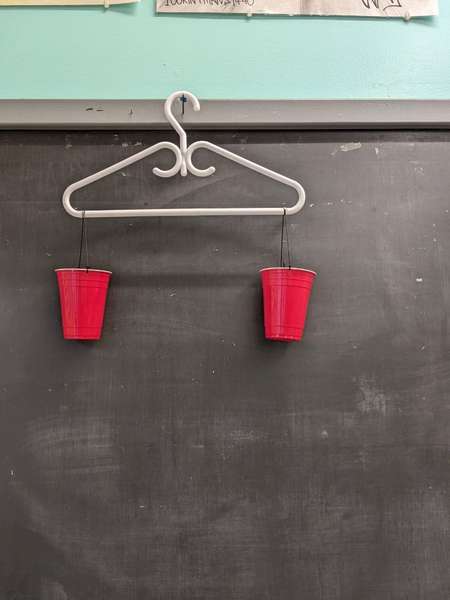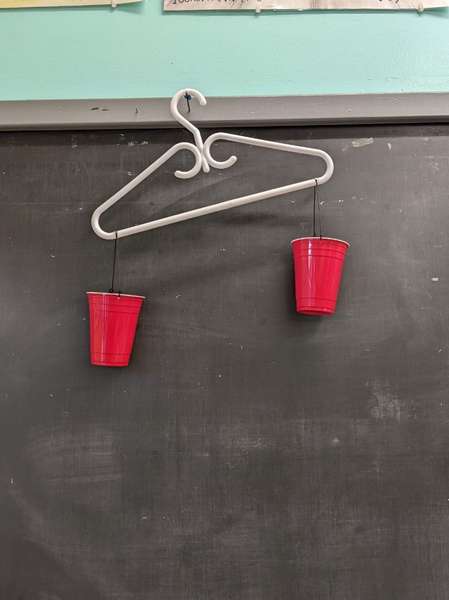Tipping the Scales to Teach Basic Algebra
★★★★★

This is the story of how two plastic cups, a coat hanger, and some string revolutionized the way I teach algebra.
It started one year when I was teaching my sixth graders some introductory algebra—basically a lot of solving for unknown variables in addition, subtraction, multiplication, and division equations by using the inverse operation.
My students were struggling with the concept, and I couldn’t figure out why. One breakthrough came when I realized they had a fundamental misunderstanding of an equal sign.
It seems so basic, but in the lower elementary years, students are subconsciously trained to think that an equal sign means you need to do something. They are given pages of math facts like “9+1=__” and told to solve them. Most of their experiences with equal signs require them to write the answer following the sign, hence the mindset that seeing an equal sign calls for an action from them.
Really, though, that is not what an equal sign means. Rather than being an instruction for action, it is a description of reality. It is simply saying that what is on one side of the sign is the same as what is on the other side of the sign. 9+1=10 because 9+1 is exactly the same thing as 10; it’s just a different way of saying it. Helping students understand this is essential to their ability to understand algebra.
A helpful analogy is to compare the equal sign to a balance scale—what is on one side of the sign must be exactly the same amount as what is on the other side; otherwise it isn’t truly equal. After spending some time looking at balance scales on Amazon and deciding they were out of my price range, I crafted a simple DIY version out of two cups suspended from either end of a coat hanger.

It’s not perfect, and it’s certainly not completely precise, but it gets the idea across.
I used marbles as my “numbers,” but you could use any objects as long as they are all the same size, shape, and weight as each other.
I started at a basic level with my students, as I wanted to break down their root misconceptions about the equal sign. We spent some time physically placing marbles in the cups and having them answer questions like the following:
If I have 4 marbles in the first cup, then I add 5 more, how many marbles would I have to put in the second cup to make the scale balance? What is the mathematical equation for what we just did? (4+5=9)
If I have 7 marbles in the first cup, then I take away 2 of them, how many marbles would I put in the second cup to make the scale balance? What is the mathematical equation for what we just did? (7-2=5)
If I put 3 groups of 5 marbles into the first cup, how many marbles would I put in the second cup to make the scale balance? What is the mathematical equation for what we just did? (3×5=15)
I spent as long as I needed to on this step until I was sure my students understood the concept. Once they did, I knew they were much better prepared to understand conceptually what an algebraic equation is saying.
The beauty of the balance scale goes a step further, however.
I prepared my scale before class with something like this:
In the left cup, I had five loose marbles and four concealed to be “x.” I simply wrapped four marbles in paper towel and used a marker to draw an x on the package. You could hide the unknown amount however you wish—I like paper towel because it’s fairly lightweight and shouldn’t throw off the equilibrium of the scale too much. (Although since the coat hanger scale is questionable in its exact accuracy anyways, you can get away with more than you could with a real, precise balance scale).
I then filled the right cup with 9 marbles so that the scale was balanced.
When class time came, I showed the students what was in each cup. We worked together to write an equation to illustrate what was on each side of the scale. (x+5=9)
Then, I said, “Now, you might already know what x is in this equation just because of your knowledge of math facts. Pretend that you don’t. Your task is to come up with a way to know how many marbles are in the x package without using math facts and without opening the package. You may simply add or take away marbles from the cups.”
And then I let them wrestle over it together. We tried their ideas until we found one that worked. I found it was such a great way to force my students to engage with the underlying concept, not just give them step-by-step instructions of how to solve the problems.
There are different ways the students can think of to solve the puzzle, and that is fine. Like most things in math, there is more than one path to the right answer, and it’s good for them to see that.
However, regardless of their method of solving the problem, I always conclude by taking the time to walk through exactly what happens when we do the steps we will learn to solve the equation x+5=9.
- We want to get x by itself, so we take away the 5 other marbles, leaving only the x package.
- Notice that the scale is unbalanced. We don’t want that, or else our equal sign isn’t true.
- Do exactly the same thing on the other side (remove 5 marbles), so that the scale balances again.
- Count how many marbles are left in the cup on the right side. Realize there must be 4 marbles on the left side, too.
- Check if we’re right by opening the x package.
And suddenly, for my students, algebra was no longer this strange, nebulous world where we inexplicably added the alphabet to math and nothing made sense anymore. It took more time and effort than teaching them a list of steps would have, but the pay-off of them actually understanding what was happening was priceless.
I used the same visual representation to teach multiplication equations. To illustrate 3×6=18, for instance, I made three paper towel x packages with six marbles in each for one side of the scale. The other side got 18 loose marbles. We then solved by taking the 18 loose marbles and dividing them into three even groups, resulting in six in each group.
I found it worked best for showing addition and multiplication problems, though you could illustrate subtraction and division too, if you wish.
Another time the balance scale helped my students was when they first encountered an equation that was written backwards of what they were used to. After seeing equations such as x+3=12, suddenly having it written as 12=x+3 can be confusing for them. All I had to do was walk over to my balance scale and flip it around. The understanding that dawned in their eyes without me even saying a word was a beautiful thing.
Sometimes, knowing how to counter student confusion can be difficult, especially when it’s rooted in deep, conceptual misunderstandings. But for me and my students, confusion about algebra was solved with a few simple household objects and a bit of imagination. I hope it can do the same for you.
Related Items
Leave a Reply
Feedback